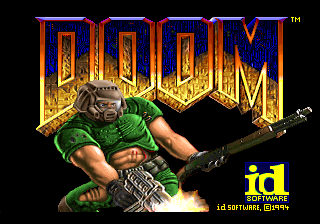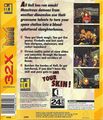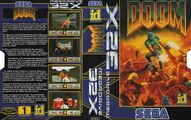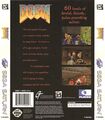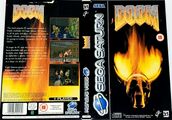Difference between revisions of "Doom (32X)"
From Sega Retro
Bartman3010 (talk | contribs) |
Bartman3010 (talk | contribs) m (→Saturn Version) |
||
| Line 63: | Line 63: | ||
===Saturn Version=== | ===Saturn Version=== | ||
| − | The Sega Saturn version of ''Doom'' was a rushed port of the Playstation version that as poorly received by critics. Foe example, the framerate suffered greatly during gameplay. Otherwise, the game features the same content as the Playstation version including both 'Doom'' and ''Doom II'', with some changes to accommodate for the lost power on the console. It also contains the new levels the PlayStation version has, such as Club Doom. In addition, there were a number of differences between versions released the America, European and Japanese versions of the game. For example, the American release does not feature multiplayer of any sort, despite being advertised on the box and has the worst system performance. The Japanese release came out at a later date and features improved performance. The European release of the game features multiplayer using the Sega Saturn Link Cable which also requires two copies of the game played through two consoles. Multiplayer allows two players to play the game in Cooperative or Deathmatch modes on all the levels (The boss levels however do not have level exits, where the only way to end an unlimited match is to quit the game.) | + | The Sega Saturn version of ''Doom'' was a rushed port of the Playstation version that as poorly received by critics. Foe example, the framerate suffered greatly during gameplay. Otherwise, the game features the same content as the Playstation version including both ''Doom'' and ''Doom II'', with some changes to accommodate for the lost power on the console. It also contains the new levels the PlayStation version has, such as Club Doom. In addition, there were a number of differences between versions released the America, European and Japanese versions of the game. For example, the American release does not feature multiplayer of any sort, despite being advertised on the box and has the worst system performance. The Japanese release came out at a later date and features improved performance. The European release of the game features multiplayer using the Sega Saturn Link Cable which also requires two copies of the game played through two consoles. Multiplayer allows two players to play the game in Cooperative or Deathmatch modes on all the levels (The boss levels however do not have level exits, where the only way to end an unlimited match is to quit the game.) |
==Production Credits== | ==Production Credits== | ||
Revision as of 03:23, 19 July 2012
| Doom (32X) | |||||
|---|---|---|---|---|---|
| System(s): Sega 32X, Sega Saturn | |||||
| Publisher: Sega, GT Interactive (US/EU), Soft Bank (JP) | |||||
| Developer: id Software | |||||
| Genre: Shooter | |||||
| |||||
Doom (in Japan either as DOOM or as ドゥーム) is a first person shooter developed by id Software and released on December 10, 1993 for DOS-based IBM PC compatibles. It was later ported to numerous platforms, two of which are Sega consoles; the Sega 32X and Sega Saturn. It is widely considered to be one of the games that pioneered and popularized the first person shooter genre, and retains a large, dedicated fanbase to this day.
The player assumes the role of a nameless space marine and through use of a varied set of weaponry, must fight his way through moonbases on Mars and the depths of Hell itself.
Contents
Gameplay
The game is played through the eyes of the main character. The player navigates through the level and collects weapons, ammunition, powerups, and other miscellaneous items. Certain doors are locked via a red, blue, or yellow keycard which are hidden throughout the level. Eventually the player finds the exit and progresses to the next level. Every so often a boss is encountered, where the level ends upon defeating the boss.
Levels are often made more varied by use of gimmicks and traps such as elevators, poisonous pits, monster closets, and secret rooms.
Differences from PC Version
32X Version
Due to hardware limitations, the 3D portion of the screen is shrunken. Although the 32X is technically capable of rendering the full screen, performance concerns caused the developers to shrink the screen during development.
The level design and texturing in several levels is noticeably changed, presumably for the sake of performance, hardware constraints, and/or aesthetics on a TV screen as opposed to a computer monitor.
Due to storage space limitations on a cartridge, the 32X version contains a reduced set of levels from the PC version. The music was also noticeably changed, the developers deciding to remake the soundtrack with GEMS and keep it on the Mega Drive side only rather than use the 32X's PWM — having to make launch date didn't help the situation either. It's known by many fans and critics as the worst version of Doom's music for any console port, with even the SNES surpassing it in terms of quality. The game now features a level select menu, allowing the player to select any level within the game; however, by using the level select, the game only presents the user with a DOS prompt at the end, instead of giving the true ending away.
Interestingly enough, even after the game was released to the market, the developers continued adding onto the game. These versions were leaked in the February 23rd, 2008 Proto Release by drx.
Prototypes
Scene member drx released a few demos of Doom on the 32X, showcasing a better engine and direct ports of the PC levels before being changed.
Saturn Version
The Sega Saturn version of Doom was a rushed port of the Playstation version that as poorly received by critics. Foe example, the framerate suffered greatly during gameplay. Otherwise, the game features the same content as the Playstation version including both Doom and Doom II, with some changes to accommodate for the lost power on the console. It also contains the new levels the PlayStation version has, such as Club Doom. In addition, there were a number of differences between versions released the America, European and Japanese versions of the game. For example, the American release does not feature multiplayer of any sort, despite being advertised on the box and has the worst system performance. The Japanese release came out at a later date and features improved performance. The European release of the game features multiplayer using the Sega Saturn Link Cable which also requires two copies of the game played through two consoles. Multiplayer allows two players to play the game in Cooperative or Deathmatch modes on all the levels (The boss levels however do not have level exits, where the only way to end an unlimited match is to quit the game.)
Production Credits
id Software
Design: Shawn C. Green, Sandy Petersen, John Romero
Programming: Michael Abrash, John Carmack, John Romero, Dave Taylor
Graphics / Artwork: Adrian Carmack, Kevin Cloud
Tech Support: Shawn C. Green
Level Design: John Romero, Sandy Petersen, Shawn C. Green
Music: Robert Prince
Sound Effects: Robert Prince
Sound: Paul Radek
Tools Programming: John Romero
Audio Drivers: Paul Radek
Creative Director: Tom A. Hall
Biz: Jay Wilbur
Special Thanks To: Martin Kolodziej
Sega
Producer: Jesse Taylor
Assistant Producers: Vincent Nason, Greg Becksted
Product Manager: Tim Dunley
Product Specialist: Nemer Velasquez
Programming: Jonathan Flamm, Robert Hardy, Unni Pillai, Toshi Morita
Art: Jenny Martin, Susan Greene
Music: Brian Coburn
Game Lead: Michael Baldwin
Assistant Game Leads: Joel Breton, Christopher Lucich, Matt Underwood
Testers: Fernando Valderrama, Aaron Loichinger, Kim Rogers, Ben Cureton, Lloyd Kinoshita, Aaron Hommes
Manual: Carol Ann Hanshaw, Jay Wilbur
Special Thanks: Haven Dubrul, David Albert, Robert W. Lindsey, Doria Sanchez
Manuals
Physical Scans
32X Version
| 88 | |
|---|---|
| Based on 37 reviews | |
Saturn Version
| Sega Retro Average | ||||
|---|---|---|---|---|
|
| N/A | |
|---|---|
| Based on 0 reviews | |
- ↑ Beep! MegaDrive, "January 1995" (JP; 1994-12-08), page 26
- ↑ Computer & Video Games, "January 1995" (UK; 1994-12-15), page 72
- ↑ Computer + Video Giochi, "Gennaio 1995" (IT; 199x-xx-xx), page 76
- ↑ Electronic Games (1992-1995), "February 1995" (US; 1995-0x-xx), page 74
- ↑ Electronic Gaming Monthly, "January 1995" (US; 199x-xx-xx), page 40
- ↑ Famitsu, "1994-12-09" (JP; 1994-11-25), page 39
- ↑ FLUX, "Issue #4" (US; 1995-xx-xx), page 82
- ↑ GameFan, "Volume 2, Issue 12: December 1994" (US; 1994-xx-xx), page 27
- ↑ GamePro, "February 1995" (US; 199x-xx-xx), page 60
- ↑ Gamer, "Ianouários 1995" (GR; 1995-xx-xx), page 1
- ↑ Gamers, "Januar 1995" (DE; 1995-01-08), page 35
- ↑ Games World: The Magazine, "February 1995" (UK; 1994-12-xx), page 15
- ↑ Game Informer, "December 1994" (US; 1994-1x-xx), page 12
- ↑ Hobby Consolas, "Diciembre 1994" (ES; 1994-xx-xx), page 78
- ↑ Joypad, "Décembre 1994" (FR; 1994-1x-xx), page 90
- ↑ MAN!AC, "01/95" (DE; 1994-12-07), page 48
- ↑ Mega, "December 1994" (UK; 1994-11-30), page 20
- ↑ Mega Force, "Megadrive 32X elle est là!" (FR; 1994-12-02), page 22
- ↑ Mega Fun, "01/95" (DE; 1994-12-21), page 31
- ↑ Micro Kid's Multimédia, "Février 1995" (FR; 1995-0x-xx), page 60
- ↑ Micromanía (segunda época), "Diciembre 1994" (ES; 1994-xx-xx), page 22
- ↑ Mean Machines Sega, "January 1995" (UK; 1994-11-30), page 76
- ↑ Player One, "Décembre 1994" (FR; 1994-1x-xx), page 64
- ↑ Play Time, "2/95" (DE; 1995-01-04), page 101
- ↑ Power Up!, "Saturday, December 17, 1994" (UK; 1994-12-17), page 1
- ↑ Power Unlimited, "Jaargang 3, Februari 1995" (NL; 1995-01-25), page 40
- ↑ Saturn Fan, "1995 February" (JP; 1995-01-07), page 34
- ↑ Sega Magazine, "December 1994" (UK; 1994-11-15), page 70
- ↑ Sega News, "Leden 1997" (CZ; 1997-xx-xx), page 34
- ↑ Sega Power, "February 1995" (UK; 1994-12-15), page 50
- ↑ Sega Pro, "January 1995" (UK; 1994-12-01), page 40
- ↑ Sega Pro, "April 1996" (UK; 1996-02-28), page 24
- ↑ Sega Force, "2/95" (SE; 1995-04-19), page 8
- ↑ Sega Saturn Magazine, "September 1995" (JP; 1995-08-08), page 84
- ↑ Todo Sega, "Diciembre 1994" (ES; 1994-1x-xx), page 28
- ↑ Ultimate Future Games, "January 1995" (UK; 1994-12-01), page 97
- ↑ VideoGames, "December 1994" (US; 1994-1x-xx), page 72
